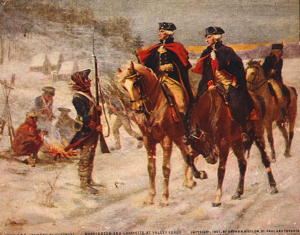
More than any other event, it was John Brown’s raid on Harpers Ferry that lit the fuse of North-South tension and ignited the Civil War. Brown planned the raid for two years in advance, so it was no mistake that the first thing he did when he crossed into Virginia was to send a detachment to steal a sword and kidnap its owner. It wasn’t just any old sword. It was – purportedly – the sword of the Prussian monarch Frederick the Great.
Legend of the Sword

The story of why Frederick the Great’s sword fascinated John Brown is a story of the symbolism in the raid. And that symbolism helped establish Brown’s reputation as a martyr.

Brown’s preparations for the raid included sending an advance man, John Edwin Cook, as a spy. Cook moved to Harpers Ferry over a year in advance. He blended in well and even married a local girl. One interesting tidbit Cook passed on to Brown had to do with a sword once belonging to Frederick the Great and two pistols once belonging to General Lafayette. Col. Lewis W. Washington, the great-grandnephew of George Washington, had inherited them and lived only four miles from Harpers Ferry. Frederick the Great had reputedly sent the sword to Washington in 1780 with a note: “From the oldest General in the world to the Greatest.”
John Brown Steals Frederick the Great’s Sword

Brown’s raiders kidnapped Washington in the middle of the night and delivered him by carriage, along with the sword and pistols, to the U.S. armory in Harpers Ferry, now under John Brown’s command. Brown kept Washington hostage in the armory’s fire engine house and wore Frederick’s sword during the following standoff. Robert E. Lee, appointed to command the U.S. troops from Fr. Monroe present in Harpers Ferry, successfully recaptured the armory.

Brown was injured and captured. Carrying Frederick’s sword might have helped save his life. When a U.S. Army lieutenant tried to strike Brown with a saber, something under Brown’s shirt deflected the blow. That something is thought to be the buckle for the belt carrying the sword. Brown, according to one source, surrendered Frederick’s sword and Lafayette’s pistols to a black man, Osborn Perry Anderson, a freeborn Pennsylvanian who had joined Brown on the raid. They were eventually returned to Washington.
Had Brown been killed immediately, he may not have become a national martyr. His stoicism in face of the death penalty is one of the things that changed him, in the eyes of the North, from an abolitionist who had gone too far to a national saint.
Why the sword? And why the pistols?
The Sword in Symbolism

John Brown planned the raid on Harpers Ferry not only on a tactical level, but also a symbolic one. Symbolism was already reflected in his selection of the date for his raid: July 4, 1859. Only because he couldn’t amass enough men and materials by Independence Day did Brown postpone the raid to October 16.

Historians today doubt whether Frederick really gave Washington a sword. It’s impossible to determine the origins of the sword because it was severely damaged in a fire in 1911. But the point is moot, because the people of the era believed it really was Frederick the Great’s sword and the role it played was symbolic. Brown had planned from the beginning to place those national heirlooms in the hands of a black man as a symbol of racial justice.
Literature on point:
Michael Korda: Clouds of Glory: The Life and Legend of Robert E. Lee (Harper, 2014)
Peggy A. Russo & Paul Finkelman, eds. Terrible Swift Sword: The Legacy of John Brown (Athens, Ohio: Ohio University Press 2005)
United States Department of the Interior; National Park Service. National Registers of Historic Places Inventory – Nomination Form for Beall-Air (Jefferson County, West Virginia) 1973.





Brown stole the sword from the North to protest slavery in the South?
Brown stole the sword from the South. Lewis Washington lived in Harpers Ferry, so he was in Virginia.
If Brown planned the raid two years in advance, he did a poor job. He chose an indefensible position in the engine house and did not proceed with taking arms to the rebellious slaves. In my opinion he planned to be a martyr and in so doing betrayed the men under his command. They were either killed in the raid or hanged later.
The sword gets far more credit for the war than is supported by the evidence.
The sword played a symbolic role, that’s true. But it’s interesting that Brown included it in his plans — one has to ask why.
Your theory about Brown planning to be a martyr is intriguing. Thanks for commenting, David.
Sorry to be so many years late on this. According to the New York Herald of October 21,1859 One of the Brown accomplices took the sword from Col. John Washington, Geo’s cousin, who was kidnapped the first night of the raid. The sword and pistols were in John’s “gun closet” at his manse. He was a token slave owner to be used as a chip in the game. Brown did not “plan” to include the sword it was simply a bit of irony that it fell into his hands from a henchman.
Thanks for adding that bit of information. Even if Brown never intended to use the sword for its symbolic value, it’s still an interesting coincidence.
The reason John Brown’s Raid of Harpers Ferry seemed like a suicide mission was because he was counting on the support of a Slave Uprisining to supply him with sufficient manpower. Planning a revolution is difficult.
That’s exactly right. Thanks for commenting.
[…] the Great incorporated the ideal of the Declaration of Independence into European law (he was an admirer of George Washington’s). Catherine the Great made copies of Frederick’s edict and sent them to all her judges in Russia. […]
Actually, the troops Robert E. Lee was commanding included U.S. Marines that President Buchanan had sent from their barracks in Washington, D.C. The lieutenant who nearly felled brown was likewise a Marine: Israel Greene, who although a Northerner, would resign his commission at the onset of the Civil War and go on to serve in the Confederate Staes Marine Corps.
That’s an interesting piece of history, Patrick. I didn’t know that. Thanks for commenting.
Very interesting.
Thank you, kind madam!
Robert E. Lee also brought an aide with him, who happened to be at the War Department when the event broke out: James Ewell Brown Stuart.
That’s an interesting historical tidbit. So many players in the Civil War had a past that involved cooperation, sometimes with their future enemies. That makes the war so poignant.
[…] the Prussian empress or two posts on Frederick the Great, a member of the Hohenzollern dynasty: How Frederick the Great’s Sword Helped Spark the Civil War and The Five Greatest Criminal Trials of History, which covers his judgment in the trial of the […]
It should be noted that as Robert E. Lee married Mary Parke Custis, a step great grandaughter of George Washington, in a sense Lee was getting back his family by marriage’s property.
That’s an interesting point — the sword once belonged to Washington, and when Lee captured it, it came back to the Washington family in a sense. You can’t make up things like that! Real history sometimes has more symbolism that does fiction.
I have no doubt that John Brown was a willing martyr; but have questions about his willingness to commit his son to that same fate. His son’s body was not allowed burial, instead sent to medical schools and used as a macabre display, only returned by friendly family admirers postwar. They lay together in the shadow of the Lake Placid NY Olympic shi jumps, site of Brown’s “Timbuctoo” farm, part of NY State’s slave sanctuary.
That is a good point — I don’t know enough about his son to say whether the son was a willing martyr as well. As least we can say is that both shaped American history. Thanks for commenting — I hadn’t known where they were buried.